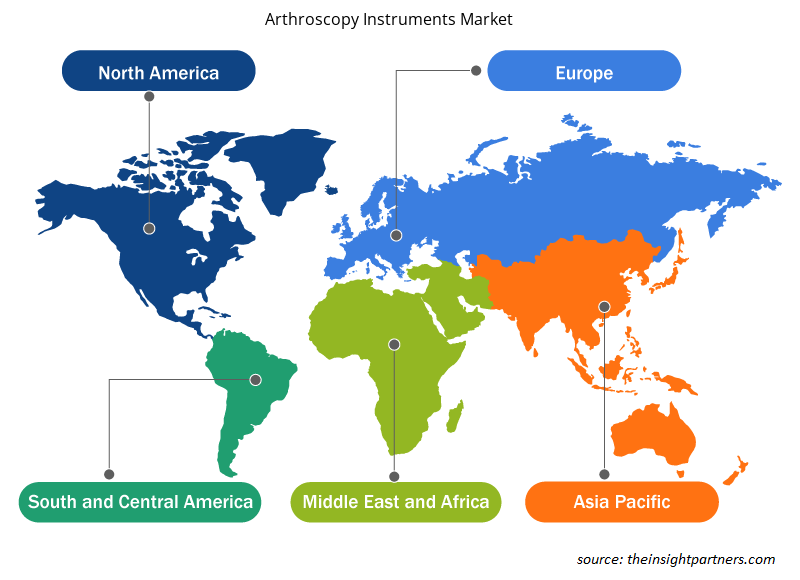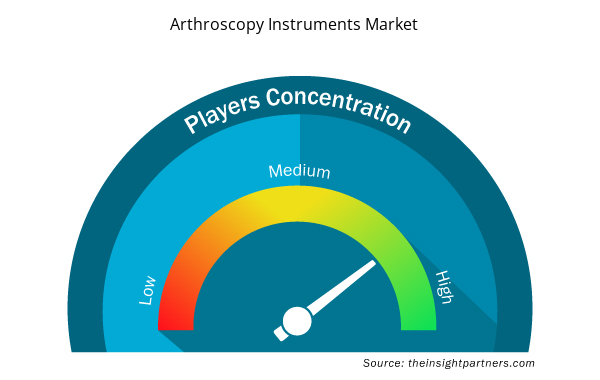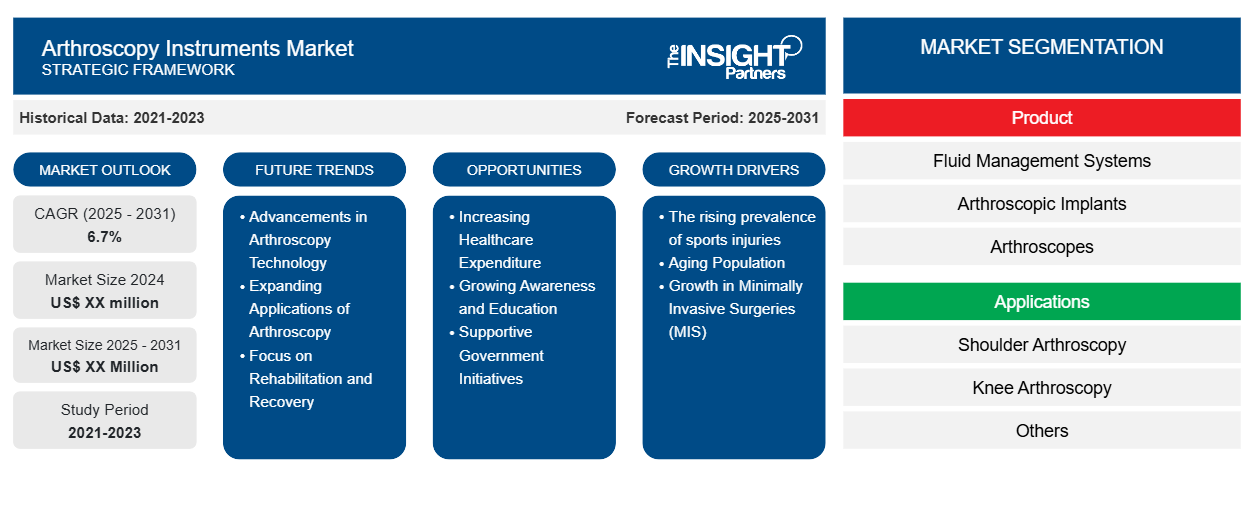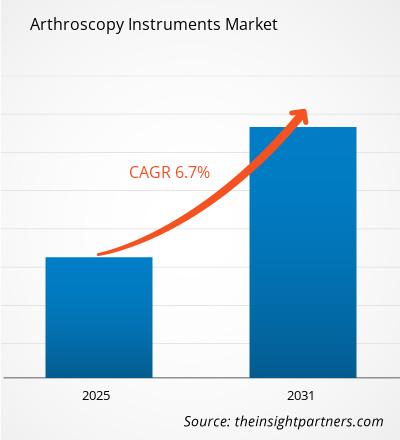Le marché des instruments d'arthroscopie devrait enregistrer un TCAC de 6,7 % de 2024 à 2031, avec une taille de marché passant de XX millions USD en 2024 à XX millions USD d'ici 2031.
Le rapport est segmenté par produit (systèmes de gestion des fluides, implants arthroscopiques, arthroscopes, systèmes de visualisation, rasoirs motorisés, systèmes d'ablation par radiofréquence (RF)) ; applications (arthroscopie de l'épaule, arthroscopie du genou, autres) ; utilisateur final (hôpitaux, centres de chirurgie ambulatoire, autres). L'analyse globale est ensuite subdivisée au niveau régional et par principaux pays. Le rapport offre la valeur en USD pour l'analyse et les segments ci-dessus.
Objectif du rapport
Le rapport sur le marché des instruments d'arthroscopie de The Insight Partners vise à décrire le paysage actuel et la croissance future, les principaux facteurs moteurs, les défis et les opportunités. Cela fournira des informations à diverses parties prenantes commerciales, telles que :
- Fournisseurs/fabricants de technologie : pour comprendre l’évolution de la dynamique du marché et connaître les opportunités de croissance potentielles, leur permettant de prendre des décisions stratégiques éclairées.
- Investisseurs : Effectuer une analyse complète des tendances concernant le taux de croissance du marché, les projections financières du marché et les opportunités qui existent tout au long de la chaîne de valeur.
- Organismes de réglementation : Réglementer les politiques et surveiller les activités du marché dans le but de minimiser les abus, de préserver la confiance des investisseurs et de maintenir l’intégrité et la stabilité du marché.
Segmentation du marché des instruments d'arthroscopie
Produit
- Systèmes de gestion des fluides
- Implants arthroscopiques
- Arthroscopes
- Systèmes de visualisation
- Rasoirs motorisés
- Systèmes d'ablation par radiofréquence
Applications
- Arthroscopie de l'épaule
- Arthroscopie du genou
- Autres
Utilisateur final
- Hôpitaux
- Centres de chirurgie ambulatoire
- Autres
Géographie
- Amérique du Nord
- Europe
- Asie-Pacifique
- Amérique du Sud et Amérique centrale
- Moyen-Orient et Afrique
Personnalisez ce rapport en fonction de vos besoins
Vous bénéficierez d'une personnalisation gratuite de n'importe quel rapport, y compris de certaines parties de ce rapport, d'une analyse au niveau des pays, d'un pack de données Excel, ainsi que d'offres et de remises exceptionnelles pour les start-ups et les universités.
- Obtenez les principales tendances clés du marché de ce rapport.Cet échantillon GRATUIT comprendra une analyse de données, allant des tendances du marché aux estimations et prévisions.
Facteurs de croissance du marché des instruments d'arthroscopie
- La prévalence croissante des blessures liées au sport : L’augmentation du taux de participation aux activités physiques et sportives a entraîné une augmentation de l’incidence des blessures liées au sport, ce qui a accru le besoin d’arthroscopie. Le nombre de personnes qui participent à des activités physiques et sportives intenses est en augmentation, et les taux de blessures augmentent également, en particulier chez les jeunes et les adultes, ce qui accroît la demande de traitements appropriés comme l’arthroscopie.
- Vieillissement de la population : le monde vieillit et, par conséquent, il est confronté à des problèmes liés aux articulations tels que l'arthrose. Cela entraîne une forte demande de procédures arthroscopiques qui traitent les conditions ci-dessus. En général, les affections liées aux articulations sont associées à une population vieillissante, ce qui signifie qu'une forte demande de chirurgies de remplacement articulaire sera constatée. La plupart des patients souffrent d'affections liées aux articulations traitées par arthroscopie dans la plupart des cas sous forme d'évaluation préopératoire, de réparation et de suivi postopératoire.
- Croissance des chirurgies mini-invasives (CMI) : En raison de la diminution des douleurs postopératoires et des périodes de récupération et de séjour à l'hôpital plus courtes, les personnes optent de plus en plus pour l'option CMI. Par conséquent, la demande en arthroscopie va augmenter. Les techniques d'arthroscopie sont appréciées non seulement par les patients âgés mais aussi par les prestataires de services en général car elles sont moins invasives que les chirurgies ouvertes traditionnelles. Elles réduisent le temps de récupération et de cicatrisation et permettent un séjour à l'hôpital plus court, ce qui les rend adaptées aux patients gériatriques.
Tendances futures du marché des instruments d'arthroscopie
- Progrès dans la technologie de l'arthroscopie : les progrès technologiques en arthroscopie, tels que les caméras haute définition, les systèmes de visualisation améliorés, la chirurgie assistée par robot et les techniques chirurgicales innovantes qui rendent la procédure d'arthroscopie plus efficace et plus sûre, sont les principaux facteurs de croissance du marché. Ces progrès devraient améliorer les résultats chez les patients âgés et font également prospérer le marché des instruments d'arthroscopie.
- Élargissement des applications de l'arthroscopie : l'expansion des domaines d'application de ces instruments dans diverses chirurgies orthopédiques telles que les poignets, les chevilles et les hanches devrait contribuer à la croissance du marché. Ces instruments sont également utilisés dans les traumatismes et autres pathologies telles que les maladies dégénératives, les maladies inflammatoires et même certains cancers, augmentant ainsi la demande d'instruments connexes.
- Accent sur la rééducation et la récupération : L'accent croissant mis sur la rééducation après une intervention chirurgicale influence la conception d'instruments permettant aux patients de récupérer plus rapidement et de reprendre leurs activités normales à long terme. Les solutions offrant des solutions complètes pour l'instrumentation chirurgicale combinées aux soins postopératoires sont de plus en plus attrayantes. Une meilleure reconnaissance des patients permet bien sûr d'adapter les protocoles en fonction de leur rythme de récupération spécifique et de leurs exigences en matière de style de vie.
Opportunités de marché pour les instruments d'arthroscopie
- Augmentation des dépenses de santé : L'augmentation des dépenses de santé a augmenté l'accès aux chirurgies arthroscopiques et des instruments chirurgicaux plus avancés sont de plus en plus disponibles. L'augmentation de la population âgée a entraîné une augmentation des dépenses consacrées aux interventions chirurgicales et aux services de réadaptation et de soins. Cela entraîne une forte demande d'instruments d'arthroscopie utilisés dans ces interventions.
- Sensibilisation et éducation croissantes : une meilleure éducation des patients et des professionnels de santé sur la procédure arthroscopique et ses avantages entraînera une expansion du marché. Les produits éducatifs destinés aux patients peuvent améliorer leurs connaissances sur les avantages possibles des procédures arthroscopiques, les motivant ainsi à suivre un traitement. L'exposition lors de conférences sur l'orthopédie et la médecine sportive offre également aux fabricants l'occasion de mettre en avant leurs derniers instruments, technologies et opportunités de formation auprès des professionnels de santé.
- Initiatives gouvernementales de soutien : L’augmentation des investissements dans les infrastructures de santé et les politiques visant à encourager les techniques chirurgicales avancées permettront d’améliorer l’accessibilité des services d’arthroscopie. Les campagnes de santé publique motivées par le gouvernement en faveur d’une chirurgie moins invasive augmenteront encore la demande d’instruments d’arthroscopie. Les partenariats avec les hôpitaux proposant des protocoles de traitement par arthroscopie augmenteront également la demande.
Aperçu régional du marché des instruments d'arthroscopie
Les tendances régionales et les facteurs influençant le marché des instruments d’arthroscopie tout au long de la période de prévision ont été expliqués en détail par les analystes d’Insight Partners. Cette section traite également des segments et de la géographie du marché des instruments d’arthroscopie en Amérique du Nord, en Europe, en Asie-Pacifique, au Moyen-Orient et en Afrique, ainsi qu’en Amérique du Sud et en Amérique centrale.

- Obtenez les données régionales spécifiques au marché des instruments d'arthroscopie
Portée du rapport sur le marché des instruments d'arthroscopie
| Attribut de rapport | Détails |
|---|---|
| Taille du marché en 2024 | XX millions de dollars américains |
| Taille du marché d'ici 2031 | XX millions de dollars américains |
| Taux de croissance annuel composé mondial (2025-2031) | 6,7% |
| Données historiques | 2021-2023 |
| Période de prévision | 2025-2031 |
| Segments couverts | Par produit
|
| Régions et pays couverts | Amérique du Nord
|
| Leaders du marché et profils d'entreprises clés |
|
Densité des acteurs du marché des instruments d'arthroscopie : comprendre son impact sur la dynamique commerciale
Le marché des instruments d'arthroscopie connaît une croissance rapide, tirée par la demande croissante des utilisateurs finaux en raison de facteurs tels que l'évolution des préférences des consommateurs, les avancées technologiques et une plus grande sensibilisation aux avantages du produit. À mesure que la demande augmente, les entreprises élargissent leurs offres, innovent pour répondre aux besoins des consommateurs et capitalisent sur les tendances émergentes, ce qui alimente davantage la croissance du marché.
La densité des acteurs du marché fait référence à la répartition des entreprises ou des sociétés opérant sur un marché ou un secteur particulier. Elle indique le nombre de concurrents (acteurs du marché) présents sur un marché donné par rapport à sa taille ou à sa valeur marchande totale.
Les principales entreprises opérant sur le marché des instruments d'arthroscopie sont :
- Arthrex
- Smith et son neveu
- DePuy Synthes
- Stryker
- CONMED
Avis de non-responsabilité : les sociétés répertoriées ci-dessus ne sont pas classées dans un ordre particulier.

- Obtenez un aperçu des principaux acteurs du marché des instruments d'arthroscopie
Principaux arguments de vente
- Couverture complète : Le rapport couvre de manière exhaustive l’analyse des produits, des services, des types et des utilisateurs finaux du marché des instruments d’arthroscopie, offrant un paysage holistique.
- Analyse d’experts : Le rapport est compilé sur la base d’une compréhension approfondie des experts et analystes du secteur.
- Informations à jour : Le rapport garantit la pertinence commerciale en raison de sa couverture des informations récentes et des tendances des données.
- Options de personnalisation : ce rapport peut être personnalisé pour répondre aux exigences spécifiques du client et s'adapter parfaitement aux stratégies commerciales.
Le rapport de recherche sur le marché des instruments d’arthroscopie peut donc aider à ouvrir la voie au décodage et à la compréhension du scénario de l’industrie et des perspectives de croissance. Bien qu’il puisse y avoir quelques préoccupations valables, les avantages globaux de ce rapport ont tendance à l’emporter sur les inconvénients.
- Analyse historique (2 ans), année de base, prévision (7 ans) avec TCAC
- Analyse PEST et SWO
- Taille du marché Valeur / Volume - Mondial, Régional, Pays
- Industrie et paysage concurrentiel
- Ensemble de données Excel



Report Coverage
Revenue forecast, Company Analysis, Industry landscape, Growth factors, and Trends

Segment Covered
This text is related
to segments covered.

Regional Scope
North America, Europe, Asia Pacific, Middle East & Africa, South & Central America

Country Scope
This text is related
to country scope.
Questions fréquemment posées
Arthrex, Smith and Nephew, DePuy Synthes, Stryker, CONMED, Zimmer Biomet, Medtronic, Karl Storz, B. Braun, Olympus are the some of the key market players operating in the arthroscopy instruments market
Asia Pacific is estimated to grow at the highest CAGR over the forecast year (2023 - 2031)
The North America region accounts for highest revenue share arthroscopy instruments market
The final report will duly include market size and projection estimates for all the segments from 2021 to 2031, along with a revenue share and compound annual growth rate (%) for the regional/country-wise market wherein 2021-2022 are the historic years, 2023 is considered to be the base year, and the forecast will be provided till 2031, along with CAGR (%)
increasing prevelance of sports injuries and aging population are the major factors boosting the arthroscopy instruments market growth
The market is expected to grow at a CAGR of 6.7%
Trends and growth analysis reports related to Life Sciences : READ MORE..
1. Arthrex
2. Smith and Nephew
3. DePuy Synthes
4. Stryker
5. CONMED
6. Zimmer Biomet
7. Medtronic
8. Karl Storz
9. B. Braun
10. Olympus
The Insight Partners performs research in 4 major stages: Data Collection & Secondary Research, Primary Research, Data Analysis and Data Triangulation & Final Review.
- Data Collection and Secondary Research:
As a market research and consulting firm operating from a decade, we have published and advised several client across the globe. First step for any study will start with an assessment of currently available data and insights from existing reports. Further, historical and current market information is collected from Investor Presentations, Annual Reports, SEC Filings, etc., and other information related to company’s performance and market positioning are gathered from Paid Databases (Factiva, Hoovers, and Reuters) and various other publications available in public domain.
Several associations trade associates, technical forums, institutes, societies and organization are accessed to gain technical as well as market related insights through their publications such as research papers, blogs and press releases related to the studies are referred to get cues about the market. Further, white papers, journals, magazines, and other news articles published in last 3 years are scrutinized and analyzed to understand the current market trends.
- Primary Research:
The primarily interview analysis comprise of data obtained from industry participants interview and answers to survey questions gathered by in-house primary team.
For primary research, interviews are conducted with industry experts/CEOs/Marketing Managers/VPs/Subject Matter Experts from both demand and supply side to get a 360-degree view of the market. The primary team conducts several interviews based on the complexity of the markets to understand the various market trends and dynamics which makes research more credible and precise.
A typical research interview fulfils the following functions:
- Provides first-hand information on the market size, market trends, growth trends, competitive landscape, and outlook
- Validates and strengthens in-house secondary research findings
- Develops the analysis team’s expertise and market understanding
Primary research involves email interactions and telephone interviews for each market, category, segment, and sub-segment across geographies. The participants who typically take part in such a process include, but are not limited to:
- Industry participants: VPs, business development managers, market intelligence managers and national sales managers
- Outside experts: Valuation experts, research analysts and key opinion leaders specializing in the electronics and semiconductor industry.
Below is the breakup of our primary respondents by company, designation, and region:

Once we receive the confirmation from primary research sources or primary respondents, we finalize the base year market estimation and forecast the data as per the macroeconomic and microeconomic factors assessed during data collection.
- Data Analysis:
Once data is validated through both secondary as well as primary respondents, we finalize the market estimations by hypothesis formulation and factor analysis at regional and country level.
- Macro-Economic Factor Analysis:
We analyse macroeconomic indicators such the gross domestic product (GDP), increase in the demand for goods and services across industries, technological advancement, regional economic growth, governmental policies, the influence of COVID-19, PEST analysis, and other aspects. This analysis aids in setting benchmarks for various nations/regions and approximating market splits. Additionally, the general trend of the aforementioned components aid in determining the market's development possibilities.
- Country Level Data:
Various factors that are especially aligned to the country are taken into account to determine the market size for a certain area and country, including the presence of vendors, such as headquarters and offices, the country's GDP, demand patterns, and industry growth. To comprehend the market dynamics for the nation, a number of growth variables, inhibitors, application areas, and current market trends are researched. The aforementioned elements aid in determining the country's overall market's growth potential.
- Company Profile:
The “Table of Contents” is formulated by listing and analyzing more than 25 - 30 companies operating in the market ecosystem across geographies. However, we profile only 10 companies as a standard practice in our syndicate reports. These 10 companies comprise leading, emerging, and regional players. Nonetheless, our analysis is not restricted to the 10 listed companies, we also analyze other companies present in the market to develop a holistic view and understand the prevailing trends. The “Company Profiles” section in the report covers key facts, business description, products & services, financial information, SWOT analysis, and key developments. The financial information presented is extracted from the annual reports and official documents of the publicly listed companies. Upon collecting the information for the sections of respective companies, we verify them via various primary sources and then compile the data in respective company profiles. The company level information helps us in deriving the base number as well as in forecasting the market size.
- Developing Base Number:
Aggregation of sales statistics (2020-2022) and macro-economic factor, and other secondary and primary research insights are utilized to arrive at base number and related market shares for 2022. The data gaps are identified in this step and relevant market data is analyzed, collected from paid primary interviews or databases. On finalizing the base year market size, forecasts are developed on the basis of macro-economic, industry and market growth factors and company level analysis.
- Data Triangulation and Final Review:
The market findings and base year market size calculations are validated from supply as well as demand side. Demand side validations are based on macro-economic factor analysis and benchmarks for respective regions and countries. In case of supply side validations, revenues of major companies are estimated (in case not available) based on industry benchmark, approximate number of employees, product portfolio, and primary interviews revenues are gathered. Further revenue from target product/service segment is assessed to avoid overshooting of market statistics. In case of heavy deviations between supply and demand side values, all thes steps are repeated to achieve synchronization.
We follow an iterative model, wherein we share our research findings with Subject Matter Experts (SME’s) and Key Opinion Leaders (KOLs) until consensus view of the market is not formulated – this model negates any drastic deviation in the opinions of experts. Only validated and universally acceptable research findings are quoted in our reports.
We have important check points that we use to validate our research findings – which we call – data triangulation, where we validate the information, we generate from secondary sources with primary interviews and then we re-validate with our internal data bases and Subject matter experts. This comprehensive model enables us to deliver high quality, reliable data in shortest possible time.


 Obtenez un échantillon gratuit pour ce rapport
Obtenez un échantillon gratuit pour ce rapport